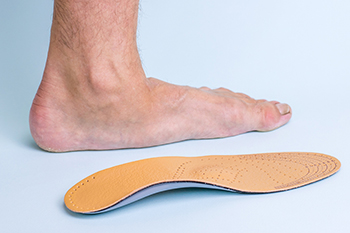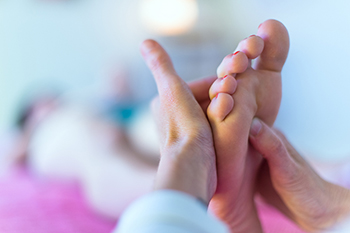Items filtered by date: February 2023
Is Having Flat Feet Always a Problem?

When an individual has flat feet, it means they have low or no arches in their feet. With this condition, their feet lie flat on the ground. The arches in the foot provide a spring to the step and help in distributing body weight. Arches need to be sturdy and flexible to accommodate movement on various surfaces. If a person has flat feet, their feet may roll inward when standing or walking which is known as overpronation. Having flat feet or pes planus, can cause no problems whatsoever, or it can cause pain, swelling, and stiffness. It can also affect the legs and impair posture. Children are flat-footed until their teen years. Adults can develop flat feet from genetics or underlying conditions, such as arthritis. Treatment for flat feet can be as simple as wearing supportive and cushioned shoes, obtaining orthotics, and performing exercises to minimize soreness. If you are an adult with flat feet and you experience pain or discomfort, it is suggested that you see a podiatrist for evaluation and treatment options that can provide relief.
Flatfoot is a condition many people suffer from. If you have flat feet, contact Ramin Nadjafi, DPM from Advanced Podiatry Group. Our doctor will treat your foot and ankle needs.
What Are Flat Feet?
Flatfoot is a condition in which the arch of the foot is depressed and the sole of the foot is almost completely in contact with the ground. About 20-30% of the population generally has flat feet because their arches never formed during growth.
Conditions & Problems:
Having flat feet makes it difficult to run or walk because of the stress placed on the ankles.
Alignment – The general alignment of your legs can be disrupted, because the ankles move inward which can cause major discomfort.
Knees – If you have complications with your knees, flat feet can be a contributor to arthritis in that area.
Symptoms
- Pain around the heel or arch area
- Trouble standing on the tip toe
- Swelling around the inside of the ankle
- Flat look to one or both feet
- Having your shoes feel uneven when worn
Treatment
If you are experiencing pain and stress on the foot you may weaken the posterior tibial tendon, which runs around the inside of the ankle.
If you have any questions please feel free to contact our office located in Orlando, FL . We offer the newest diagnostic and treatment technologies for all your foot and ankle needs.
Pregnancy and Foot Discoloration

When a pregnant woman brings a baby to term, her feet might undergo different and significant changes. For example, during a woman’s pregnancy, she might experience increased swelling in the feet, larger feet, and achy sensations in the feet. One often overlooked symptom of pregnancy is discoloration in the feet. Discoloration is another word for the alteration of color in human skin. Interestingly, discoloration in the skin is a common symptom that some women experience during pregnancy. The feet are certainly no exception to this phenomenon. Specifically, some pregnant women may notice that the soles of their feet have become more red. If you are pregnant or are planning to be, consider contacting a podiatrist today who will help you maintain the health of your feet throughout your pregnancy.
Pregnant women with swollen feet can be treated with a variety of different methods that are readily available. For more information about other cures for swollen feet during pregnancy, consult with Ramin Nadjafi, DPM from Advanced Podiatry Group. Our doctor will attend to all of your foot and ankle needs.
What Foot Problems Can Arise During Pregnancy?
One problem that can occur is overpronation, which occurs when the arch of the foot flattens and tends to roll inward. This can cause pain and discomfort in your heels while you’re walking or even just standing up, trying to support your baby.
Another problem is edema, or swelling in the extremities. This often affects the feet during pregnancy but tends to occur in the later stages.
How Can I Keep My Feet Healthy During Pregnancy?
- Wearing orthotics can provide extra support for the feet and help distribute weight evenly
- Minimize the amount of time spent walking barefoot
- Wear shoes with good arch support
- Wear shoes that allow for good circulation to the feet
- Elevate feet if you experience swelling
- Massage your feet
- Get regular, light exercise, such as walking, to promote blood circulation to the feet
If you have any questions please feel free to contact our office located in Orlando, FL . We offer the newest diagnostic and treatment technologies for all your foot and ankle needs.
What Are The Benefits of Foot Therapy?

Foot massages are a popular form of foot therapy. Many people enjoy the overall well being they feel when foot massages are performed. This can tie in to foot reflexology, as the therapist applies pressure to various areas of the foot. This is referred to as zone therapy, and it can be helpful in improving circulation and stimulating nerves. Foot therapy may provide relief from injuries, and it can help to relieve the aching feeling from daily walking and standing. Additionally, studies have shown the benefits of foot reflexology may boost mood, improve sleep, and sharpen thinking. Some patients have noticed improvement in managing headaches and muscle aches when frequent foot therapy is applied. If you have questions and concerns about various types of foot therapy, it is suggested that you speak with a podiatrist who can provide you with the information you are seeking.
Foot therapy is often necessary for those recovering from either foot deformities or foot injuries. If you have concerns regarding therapy, consult with Ramin Nadjafi, DPM from Advanced Podiatry Group. Our doctor can provide the care you need to keep you pain-free and on your feet.
Most Common Injuries
People who are active or athletes are prone to a variety of injuries. Therefore, it is often important to take part in physical therapy in order to quickly get back on the right track.
What to Do When Injured
Physical Therapy – This specialized treatment will focus on the affected area, speeding up recovery and the overall healing process. It is a proven method that has helped millions of people return from any injury.
During physical therapy you will undergo regimented training to get back into full form. Training is often very difficult, especially at first when the foot feels weak. Physical therapy often involves:
Basic stretching and twisting exercises – getting the feet’s mobility and flexibility up.
Massaging – the therapist will massage the injured area in order to activate the muscles and relax them.
Strengthening Exercises – this allows the muscles in the affected area to regain their full strength, a vital step towards full recovery.
If you have any questions please feel free to contact our office located in Orlando, FL . We offer the newest diagnostic tools and technology to treat your foot and ankle needs.
Arthritis Can Cause Pain in the Feet and Ankles
Plantar Warts May Grow in Clusters

Many warts are not painful, and this often depends on where they develop on the foot. A plantar wart grows inward on the sole of the foot, and this happens from the weight the feet must endure. It appears as a thick, rough patch of skin and may have black dots in the center. It is caused by the human papillomavirus, or HPV, and can enter the body through small cracks in the skin. This virus lives in warm environments, such as public swimming pools, locker rooms, and shower room floors. Wearing flip flops or water shoes is recommended while frequenting these types of places, which may help to prevent the virus from invading the skin. A plantar wart may grow in size, and there may be a cluster of them. If you have developed plantar warts, please contact a podiatrist who can choose one of several treatment methods that are correct for you.
Plantar warts can be very uncomfortable. If you need your feet checked, contact Ramin Nadjafi, DPM from Advanced Podiatry Group. Our doctor will assist you with all of your foot and ankle needs.
About Plantar Warts
Plantar warts are the result of HPV, or human papillomavirus, getting into open wounds on the feet. They are mostly found on the heels or balls of the feet.
While plantar warts are generally harmless, those experiencing excessive pain or those suffering from diabetes or a compromised immune system require immediate medical care. Plantar warts are easily diagnosed, usually through scraping off a bit of rough skin or by getting a biopsy.
Symptoms
- Lesions on the bottom of your feet, usually rough and grainy
- Hard or thick callused spots
- Wart seeds, which are small clotted blood vessels that look like little black spots
- Pain, discomfort, or tenderness of your feet when walking or standing
Treatment
- Freezing
- Electric tool removal
- Laser Treatment
- Topical Creams (prescription only)
- Over-the-counter medications
To help prevent developing plantar warts, avoid walking barefoot over abrasive surfaces that can cause cuts or wounds for HPV to get into. Avoiding direct contact with other warts, as well as not picking or rubbing existing warts, can help prevent the further spread of plantar warts. However, if you think you have developed plantar warts, speak to your podiatrist. He or she can diagnose the warts on your feet and recommend the appropriate treatment options.
If you have any questions please feel free to contact our office located in Orlando, FL . We offer the newest diagnostic and treatment technologies for all your foot and ankle needs.

